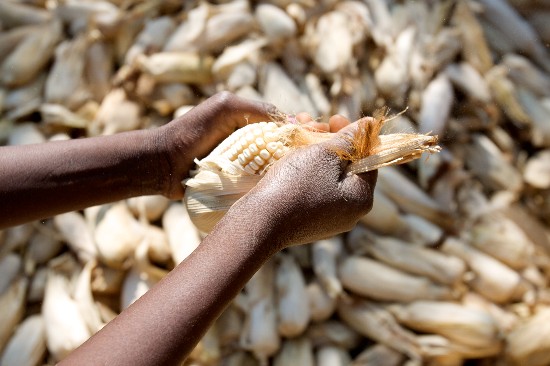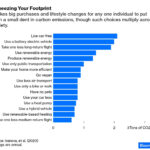In this third installment of our look at the human challenges we face today globally, we address the issue of growing food insecurity exacerbated by anthropogenic climate change and a reluctance on the part of many to embrace the scientific advancements in genetics and the creation of new technologies that allow us to enhance what we grow and eat.
Food insecurity is directly linked to human population growth. Where our population is growing the fastest, that’s where we find threats of famine. And that also coincides with where humans are poorest and most susceptible to anthropogenic climate change.
Climate change, the world population of both humans and livestock, declining natural resources, and the continuation of poor policy decision-making are all contributing the food insecurity globally. Let’s address these issues:
The Climate Change Impact on Food Insecurity
By 2050 the world’s atmosphere over land and oceans will all have warmed further whether we start ratcheting down carbon emissions immediately or not. The latent effects of current greenhouse gasses (GHGs) in the atmosphere, in particular, carbon dioxide (CO2) make this forecast a certainty.
The IPCC’s latest report states we are already seeing land atmospheric temperatures 1.59 Celsius (2.86 Fahrenheit) above pre-industrial revolution values. And median atmospheric temperatures over our oceans have risen 0.88 Celsius (1.58 Fahrenheit). By 2050 the two numbers will continue to climb.
What is the implication for agricultural production in tropical and subtropical zones of the planet? The change in temperatures will also mean changes to precipitation patterns. It means land once suitable for particular crops will become less suitable. And crop yields on more marginal agricultural lands will likely be impacted negatively.
Current modelling points to an expanded temperate farming zone in both the Northern and Southern Hemispheres. But it also shows climate variability and a frequency increase in extreme conditions from hot to cold, and wet to drought. And current modelling shows a decrease in tropical and sub-tropical farming as air temperatures become too hot for plants, animals, and the farmers who tend to both.
Increasing CO2 which is expected to hit 550 parts per million by 2100, will have both negative and positive consequences for plants. The planet will be greener when viewed from space but crops will be less nutritious. And whether in North or South America, Eurasia, Australasia or in Pacific island nations, what we grow and where we grow will change. In areas today such as sub-Saharan Africa and parts of South Asia, where we already are seeing chronic undernourishment, food production and food safety will further destabilize.
Why will increased atmospheric warming impact food safety? Because the altering conditions will affect disease vectors, the integrity of harvested crops, access to freshwater, and an increase in food reliability. All of these conditions will further impact human and livestock populations, affect labour productivity, increase poverty, and see a rise in mortality.
In addition, the cost of food will become a factor of a warming climate. Rising prices will affect affordability and make those who are the poorest suffer most. Currently, the world is witness to a climate change famine in Madagascar. In the future, vulnerable areas like the southern half of the Indian subcontinent, sub-Saharan Africa, and South Asia may experience similar conditions.
The drying out of continental interiors in North America, Asia, and Australia will reduce crops yields. And even if the poleward march of warming temperatures opens up new farming opportunities, the variable quality of the soils and the nutritional content of yields will mean less reliability for food security.
Where Science and Technology Can Help Us
Recent advances in farming practices, science, and technology are helping to counter the narrative described above. These advances along with improvements to infrastructure in Developing World countries will help reduce crop losses, improve post-harvest food preservation, and upgrade transportation from field to table to ensure better distribution to consumers.
At a recent webinar I attended on farming and climate change, I listened to farmers and agribusiness people describe improving practices that pull CO2 from the air into the soil. They talked about perennial polyculture, cover and intercropping farming and why adding carbon to the soil helps increase yields while drawing down on atmospheric CO2 to mitigate global warming.
But what wasn’t discussed was genetic crop science, probably the most important technological and scientific breakthrough to have direct implications for future food security globally. What this is all about is the improvement to plants through genetic editing using a variety of tools and techniques including CRISPR, the gene-splicing breakthrough I have written about before, to give farmers the ability to grow more even in the face of extreme growing conditions caused by climate change.
These genetic technologies provide an answer to a planet whose human population continues to climb even in the face of global warming and its impact on food production. With current world population growth, the need for farmers to increase production by 50% to meet food demand in 2050 is apparent. And diets are changing with the Developing World’s increased demand for more meat and dairy in their populations’ diets. This demand is leading to Amazon, African and South Asian deforestation pressures to make more agricultural land available.
Then there is the government regulatory bias against genetically modifying plants and animals supported by environmental groups such as Greenpeace who see evil in the science, and have labelled these products as “Frankenfoods.” Today to get a genetically modified crop approved can take two or more years. And whereas most governments on the planet believe in the science associated with our COVID-19 pandemic response, where agriculture is concerned, however, they reject the science imposing arbitrary regulation heavily influenced by uninformed consumer pressures.
Arable land on our planet is reaching a finite limit in tropical and subtropical countries. Encroachment into forested and more marginal growing areas (i.e., the deforestation of the Amazon basin in Brazil) is only a temporary fix to what will be a chronic shortage as global warming increases.
But genetic science gives us the means to achieve more on less. Take, for example, China. The country has less arable land today than in the past. Urbanization, industrialization, and environmental degradation continue to impact arable farmland negatively. Climate change and extreme weather such as droughts are causing desertification. The result is that China has to produce more food on fewer hectares of land. That’s why the country today is the world’s largest investor in genetic research on crops. Chinese see this as insurance to help it feed 1.3 billion which is expected to peak at 1.4 billion by 2030. Genetic research and tools help China to fight the impact of climate change on crops leading to new versions of plants that are resistant to heat and drought, needing fewer pesticides and herbicides and absorbing nitrogen from the air and root systems rather than needing fertilizers manufactured from fossil fuels. Today China is self-sufficient in food but its ongoing fear of climate change has the government focused on using genetics to ensure a future with no food scarcity or famine.
The tools are readily available. The science is proven. For food security humanity needs the science of genetics to improve plants and animals that we depend on for nutrition and survival. And governments that currently follow policies that pander to the uninformed, need to recognize the validity of this science and these tools to keep food scarcity from becoming the future reality.
















